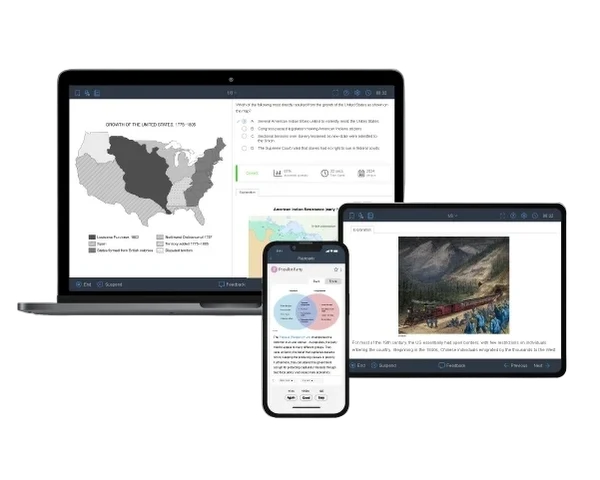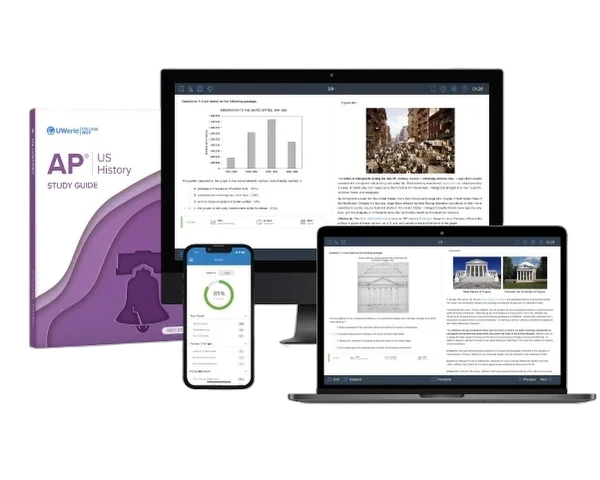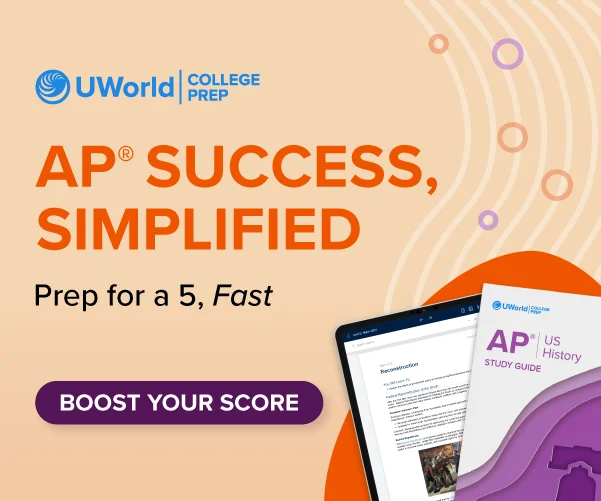What Is the Exam Format for AP U.S. History?
The AP U.S. History exam is 3 hours and 15 minutes long and is administered in digital format. The test evaluates your historical reasoning skills and understanding of the course objectives. The AP U.S. History exam format consists of two sections: multiple-choice (MCQ) and free-response questions (FRQ). Check out the table below to get a detailed understanding of the APUSH exam structure:
| Sections | Parts | Question Types | Time Allocated | Weight |
|---|---|---|---|---|
| Section I | Part A | 55 MCQs | 55 minutes | 40% |
| Part B | 3 SAQs | 40 minutes | 20% | |
| Section II | Part A | 1 DBQ | 60 minutes | 25% |
| Part B | 1 LEQ | 40 minutes | 15% |
Section I consists of both MCQs and FRQs and is divided into two parts. Part A has 55 multiple-choice questions (MCQs), and students are given 55 minutes to answer them. Part B comprises three short-answer questions (SAQs), and you'll have 40 minutes to answer those. You must note that the SAQs in Part B come in a set of two to three parts, and you’ll have to write your responses as precisely as possible within the least number of words.
Spending 1 minute per MCQ and 10 - 12 minutes on each SAQ is ideal. This method gives you ample time to go over your answers and see if there are any that you missed.
Section II of the APUSH exam consists of two types of free-response questions. Part A consists of one document-based question (DBQ), and Part B consists of one long essay question (LEQ). For the DBQ, students have 60 minutes to answer, including 15 minutes for reading, whereas for the LEQ, students get just 40 minutes to complete it.
You should take at least one AP U.S. History practice test with a format that mimics the real exam to prepare for it adequately. Doing so will help by testing you with questions that closely resemble those on the actual exam.
The AP U.S. History course comprises nine units, each carrying a specific weight on the exam. Check out the table below to learn about the units, their importance, and the chronological period each unit covers.
| Units | Topics | Chronological Period | Weight on the Exam |
|---|---|---|---|
| Unit 1 | Period 1 | 1491 to 1607 | 4%–6% |
| Unit 2 | Period 2 | 1607 to 1754 | 6%–8% |
| Unit 3 | Period 3 | 1754 to 1800 | 10%–17% |
| Unit 4 | Period 4 | 1800 to 1848 | 10%–17% |
| Unit 5 | Period 5 | 1844 to 1877 | 10%–17% |
| Unit 6 | Period 6 | 1865 to 1898 | 10%–17% |
| Unit 7 | Period 7 | 1890 to 1945 | 10%–17% |
| Unit 8 | Period 8 | 1945 to 1980 | 10%–17% |
| Unit 9 | Period 9 | 1980 to the present | 4%–6% |
Types of Questions on the AP U.S. History Exam
There are four main types of questions on the AP U.S. History exam. These questions test your historical reasoning and familiarity with the course's 8 "themes". But knowing the question types and course content does not guarantee a high score. It is crucial to understand how to respond to these questions. To help you prepare better, let’s review each question type and its format.
Want to learn more about these units and topics? Our guide to the APUSH course and exam description is here to help!
Section I, Part A: Multiple-choice Questions
As stated earlier, Section I of the AP U.S. History exam consists of 55 multiple-choice questions presented in groups of three to four questions. Each question comes with one or more stimuli, including primary texts, secondary texts, images, charts, and maps. There will also be text-based stimuli (in either the multiple-choice questions or one of the short-answer questions). Multiple-choice questions require analyzing stimulus sources and historical events and processes.
The weights of each unit for MCQs are listed below:
| Units Tested | Chronological Period | Weight of MCQs |
|---|---|---|
| [Unit 1] Period 1 | 1491 to 1607 | 1.6%-2.4% |
| [Unit 2] Period 2 | 1607 to 1754 | 2.4%-3.2% |
| [Unit 3] Period 3 | 1754 to 1800 | 04%-6.8% |
| [Unit 4] Period 4 | 1800 to 1848 | 04%-6.8% |
| [Unit 5] Period 5 | 1844 to 1877 | 04%-6.8% |
| [Unit 6] Period 6 | 1865 to 1898 | 04%-6.8% |
| [Unit 7] Period 7 | 1890 to 1945 | 04%-6.8% |
| [Unit 8] Period 8 | 1945 to 1980 | 04%-6.8% |
| [Unit 9] Period 9 | 1980 to the present | 1.6%-2.4% |
For more expert tips and strategies on how to approach APUSH MCQs, click here.
Section I, Part B: Short-answer Questions
Section I, Part B, has three short-answer questions and takes 40 minutes to complete.- Question 1 is required, and it focuses on historical events from 1754 to 1980. This question includes 1–2 secondary sources.
- Question 2 is also required. It is based on historical events from 1754 to 1980 and has one primary source.
- Students can choose to answer either Question 3, which is about historical events between 1491 and 1877, or Question 4, which is about events between 1865 and 2001.
| Units Tested | Chronological Period |
|---|---|
| [Unit 1] Period 1 | 1491 to 1607 |
| [Unit 2] Period 2 | 1607 to 1754 |
| [Unit 3] Period 3 | 1754 to 1800 |
| [Unit 4] Period 4 | 1800 to 1848 |
| [Unit 5] Period 5 | 1844 to 1877 |
| [Unit 6] Period 6 | 1865 to 1898 |
| [Unit 7] Period 7 | 1890 to 1945 |
| [Unit 8] Period 8 | 1945 to 1980 |
| [Unit 9] Period 9 | 1980 to the present |
Want to learn more? Our expert guide can show you how to approach APUSH short-answer questions with confidence.
Section II, Part A: Document-based Questions (DBQ)
The document-based question gives students seven documents related to a historical event or process. Students must:- Respond with a historically defensible claim that demonstrates reasoning.
- Explain the prompt's historical context.
- Respond to the prompt using the provided documents.
- Add historical evidence beyond the prompt's documents to your argument.
- Explain how at least three documents' points of view, purpose, historical context, or audience affect an argument.
- Use evidence to corroborate, qualify, or modify your argument about the prompt's historical development.
The historical developments or processes between 1754 and 1980 will be the focus of the document-based question.
| Units Tested | Chronological Period |
|---|---|
| [Unit 1] Period 1 | 1491 to 1607 |
| [Unit 2] Period 2 | 1607 to 1754 |
| [Unit 3] Period 3 | 1754 to 1800 |
| [Unit 4] Period 4 | 1800 to 1848 |
| [Unit 5] Period 5 | 1844 to 1877 |
| [Unit 6] Period 6 | 1865 to 1898 |
| [Unit 7] Period 7 | 1890 to 1945 |
| [Unit 8] Period 8 | 1945 to 1980 |
| [Unit 9] Period 9 | 1980 to the present |
Section II, Part B: Long-essay Questions
Students must complete the following tasks in response to the long essay question:- Respond with a historically defensible claim that demonstrates reasoning.
- Describe a broader historical context relevant to the prompt.
- Provide evidence to support your argument in response to the prompt.
- Use evidence to corroborate, qualify, or modify your argument about the prompt's historical development.
Students choose one of three essay questions. Each question uses the same reasoning to examine historical events and processes. The first option covers 1491–1800, the second 1800–1898, and the third 1890–2001.
| Units Tested | Chronological Period |
|---|---|
| [Unit 1] Period 1 | 1491 to 1607 |
| [Unit 2] Period 2 | 1607 to 1754 |
| [Unit 3] Period 3 | 1754 to 1800 |
| [Unit 4] Period 4 | 1800 to 1848 |
| [Unit 5] Period 5 | 1844 to 1877 |
| [Unit 6] Period 6 | 1865 to 1898 |
| [Unit 7] Period 7 | 1890 to 1945 |
| [Unit 8] Period 8 | 1945 to 1980 |
| [Unit 9] Period 9 | 1980 to the present |
Learn how to approach the APUSH FRQs here.

AP U.S. History Exam - Paper or Digital Format?
Starting in 2025, the AP U.S. History exam will be fully digital, with students completing the MCQ, DBQ, and FRQ sections using the Bluebook testing app.
What Do I Study To Ace the AP U.S. History Exam?
The curriculum for AP U.S. history is based on two pillars: historical reasoning skills and the 8 Themes. Exam success is equally dependent on knowing what and how to study. Therefore, it is vital to comprehend the topics and concepts included in the AP United States History exam.
The AP U.S. History exam tests historical thinking skills. Check the table below for the skills tested:
| Historical Thinking Skills | Description |
|---|---|
| Developments and Processes | Understanding historical procedures and occurrences |
| Sourcing and Situations | Source and context analysis |
| Claims and Evidence in Sources | Check primary and secondary sources for support of your argument |
| Contextualization | Knowing what to expect on the exam will give you confidence and eliminate test-day surprises |
| Making Connections | Examine historical patterns and connections (comparison, causation, continuity, and change). |
| Argumentation | Develop an argument |
For in-depth practice on historical thinking skills, use our APUSH study guide, which offers a comprehensive coverage of the content and lots of practice questions.
The exam also tests knowledge of the course's eight "Themes"
- Theme 1: American and National Identity (NAT)
- Theme 2: Work, Exchange, and Technology (WXT)
- Theme 3: Geography and the Environment (GEO)
- Theme 4: Migration and Settlement (MIG)
- Theme 5: Politics and Power (PCE)
- Theme 6: America in the World (WOR)
- Theme 7: American and Regional Culture (ARC)
- Theme 8: Social Structures (SOC)
Key Takeaways
We hope this APUSH exam format breakdown was helpful. Here are three key takeaways as you prepare for the upcoming AP U.S. History exam.
- Exam Structure: The AP U.S. History exam is divided into two main sections. In Section 1, you will encounter 55 multiple-choice questions, allowing 55 minutes to answer, and 3 short-answer questions, allowing 40 minutes to respond. Section 2 consists of 2 free-response questions, allowing 100 minutes to respond.
- Time Management: Managing your time during the exam is crucial. Remember to allocate your time wisely between the multiple-choice questions, short-answer questions, and free-response questions to ensure you complete all sections within the allotted time.
- Historical Periods: The exam covers different historical periods, from colonization to contemporary America. Be sure to allocate your study time effectively to cover all periods comprehensively.
- Skills Assessment: The exam assesses historical thinking skills, including document analysis, argumentation, and contextualization. Developing these skills is essential for earning a high score.
- Scoring: The exam is scored on a scale of 1 to 5, with 5 being the highest. Earning a top score can earn you college credit and enhance your academic journey. To maximize your study and practice, check out our AP U.S. History Course for a complete guide to mastering the exam.
Now that you know everything about the APUSH exam structure, it’s time to start practicing. Invest in your future today and unlock opportunities for advanced placement. At UWorld, we have hundreds of questions in the AP U.S. History QBank created by former AP teachers and experts. Each question has a detailed explanation to help you retain the information, and our precise performance tracking will show you where you stand and what you need to improve. Don't wait! Click the link below to enroll and kickstart your journey towards exam success.

References
- (2024). Exam Format. AP United States History. Retrieved on December 18, 2024 from https://apcentral.collegeboard.org/courses/ap-united-states-history/exam
- (2024). Course Content. AP United States History. Retrieved on December 18, 2024 from https://apcentral.collegeboard.org/courses/ap-united-states-history
- (2023). Themes. Course Content. AP United States History Course and Exam Description. Retrieved on December 18, 2024 from https://apcentral.collegeboard.org/media/pdf/ap-us-history-course-and-exam-description.pdf
Read More About the AP U.S. History Exam
Looking for a simpler U.S. History course description? Visit this page for detailed info on course units, key topics, concepts, and other necessary details.
AP U.S. History Scoring GuideCurious about how the AP U.S. History exam is scored? Find relevant information on the scoring system, criteria for free credits, and how to use the score calculator.
How to Study for AP US HistoryEnhance your AP U.S. History exam prep with expert tips, practice questions, and in-depth insights designed to help you succeed. Click here to learn more today!
Best AP U.S. History Study Guide ComparisonExplore top AP U.S. History study guides to find the best resources for the exam. Compare features, pros, cons and reviews to select the perfect guide for success.
Best AP U.S. History Prep Course ReviewSearching for top AP U.S. History prep courses? Read this review to compare the best courses and choose the perfect one for your success.
How to Self-Study for AP U.S. HistoryLearn effective tips and strategies to self-study for the AP U.S. History exam. Build confidence, master core concepts, and achieve a high score independently too.




